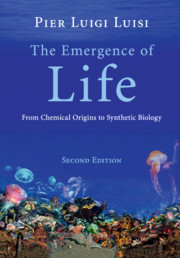Book contents
- Frontmatter
- Contents
- Acknowledgments
- Introduction
- Part I Approaches to the origin of life
- Part II What is life? The bio-logics of cellular life
- Part III Order and organization in biological systems
- Part IV The world of vesicles
- Part V Towards the synthetic biology of minimal cells
- 14 A panoramic view of synthetic biology
- 15 The minimal cell
- As a way of conclusion
- Appendix The open questions about the origin of life
- References
- Names index
- Subject index
15 - The minimal cell
from Part V - Towards the synthetic biology of minimal cells
Published online by Cambridge University Press: 05 September 2016
- Frontmatter
- Contents
- Acknowledgments
- Introduction
- Part I Approaches to the origin of life
- Part II What is life? The bio-logics of cellular life
- Part III Order and organization in biological systems
- Part IV The world of vesicles
- Part V Towards the synthetic biology of minimal cells
- 14 A panoramic view of synthetic biology
- 15 The minimal cell
- As a way of conclusion
- Appendix The open questions about the origin of life
- References
- Names index
- Subject index
Summary
Introduction
We are landing on the last section of this book, which concerns the synthetic biology approach to the minimal cell. It is in a way an approach that is in keeping with the arguments developed in Parts I and II of the book, in which we reached the conclusion that a proper way to tackle, experimentally and conceptually, the origin of life, is to focus on the biological cell.
About this, a particularly important contribution was the 1992 book by Harold Morowitz, Beginning of Cellular Life, where he expressly formulates that the first step toward the origin of life was the spontaneous condensation of amphiphilic molecules to form vesicles (or protocells). For this reason, I would like to insert at the end of this introductive section the conversation with Morowitz, which has the advantage of reconnecting us with the first two parts of this book.
In order to better understand this approach, let us consider Figure 15.1, which shows schematically two possible pathways: the first is the bottom-up approach, discussed at length in Part I. The main problem to make this pathway in the lab lies in the essence of contingency, which prevents us from knowing the detailed biogenesis structure of “our” proteins and nucleic acids.
The alternative route to the protocell, indicated in Figure 15.1, is a pathway of descending complexity – going from the modern cell to its most elementary precursor. This operation corresponds to the abstraction of eliminating conceptually all of what we may consider redundant with respect to the most basic, original functions of a primitive cell.
A note on terminology may be useful at this point, also keeping in mind Figure 15.1 with the two alternative pathways to the minimal cell. The term bottom-up is rather clear for the most common approach to the origin of life, but the terminology of the alternative route to the minimal cell is less clear. The term top-down was utilized in the early times, also by my group, to indicate that we are coming from the “top” of a full-fledged cell to arrive at a protocell. However, also in this case we are constructing a complex system starting from a simple shell, and in this sense the terminology “top-down” is not really correct.
- Type
- Chapter
- Information
- The Emergence of LifeFrom Chemical Origins to Synthetic Biology, pp. 369 - 399Publisher: Cambridge University PressPrint publication year: 2016



